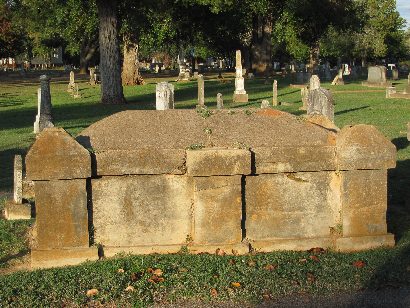| |
Nacogdochesí
Oak Grove Cemetery
is one of the oldest and most historical graveyards
in Texas, but one of its better stories has hardly
been told.
First known as ďAmerican Cemetery,Ē Oak
Grove began with the burial of one Franklin J. Starr in 1837 on a tract granted
in 1826 to empressario Haden Edwards, whoís also buried there.
Four signers
of the Texas Declaration of Independence are buried at Oak
Grove, the best known of them being Thomas Jefferson Rusk. He served as Sam
Houstonís secretary of war during the early days of the Republic of Texas
and later became the young nationís chief justice.
Three veterans of the
decisive Battle
of San Jacinto lie in the cemetery, as do the remains of veterans of many
other wars. Other burial plots are filled by the once well-to-do and the once
down-and-out, including former slaves.
The cemetery received an infusion
of even older remains in 1912 when an old Spanish graveyard was relocated to make
room for a new county
courthouse. One of those reinterments was a Father Mendoza, who died in 1718.
An historical
marker at Oak Grove, which is just east of downtown Nacogdoches,
provides a thumbnail history of the graveyard and some of its more noted occupants,
but it says nothing about W.E. Winston and Frank Robbins. |
 |
Winston,
a native Texan, fought for the South during the Civil War. In the mid-summer of
1863 at Gettsburg, he suffered a wound so severe his comrades-in-arms left him
where he fell, figuring he was dead or soon would be. But after the fighting,
someone finally noticed he was still breathing and hauled him to a field hospital.
While
hospitalized, Winston met Robbins. Like him, Robbins had been gravely wounded
during the fighting and left for dead.
Though they had shared a common
experience on the battlefield, they had one particularly big thing not in common:
Winston was a rebel and Robbins was a Yankee. |
Reunited
Americans C. 1915
War Memorial, Evanston, Illinois
TE photo, December,
2010 |
| Despite that,
the two soldiers became friends during their mutual convalescence. When they both
got their discharges, they swore that if one of them ever got in trouble, he would
seek the other out and get help, no matter what.
Shaking hands on the deal, Winston headed back to Texas
and Robbins left for his home in Ohio.
Settling in Nacogdoches,
Winston opened a foundary and soon enjoyed a prosperous business.
In 1883,
two decades after Gettsyburg changed the course of the war, a down and out fellow
walked into Winstonís place of business. It was Robbins.
Living up to his end of the bargain, Winston gave Robbins a job and they renewed
their friendship. Of course, they still had their differences. Winston was a life-long
Democrat while Robbins always voted Republican.
No matter their differing
politcal views, another thing they had in common was that neither had married
or had a family. So they became each otherís family, watching the otherís back
just like they had back in that field hospital in Pennsylvania.
As he
got older, Winston bought a lot in Oak Grove Cemetery big enough for two graves.
He made it known that were he to die first, his friend was to be buried at his
side when he passed on.
And
thatís what happened. The old Confederate went first, followed by his Yankee pal.
On Jan. 20, 1932, the Associated Press carried a short story on this unusual
pact, noting that the menís graves were unmarked. Four months later, on May 25,
the AP ran another article, telling basically the same story it had the previous
January, but noting that Winston and Robbins had a double tombstone with their
names, birth and death dates.
But www. findagrave.com, which lists some
57 million graves, has no records for either Winston or Robbins, two former enemies
united in friendship and death.
© Mike
Cox
"Texas Tales"
February 17,
2011 column
More The
Cemeteries | Texas
People |
|
Books by Mike Cox - Order Now |
| |